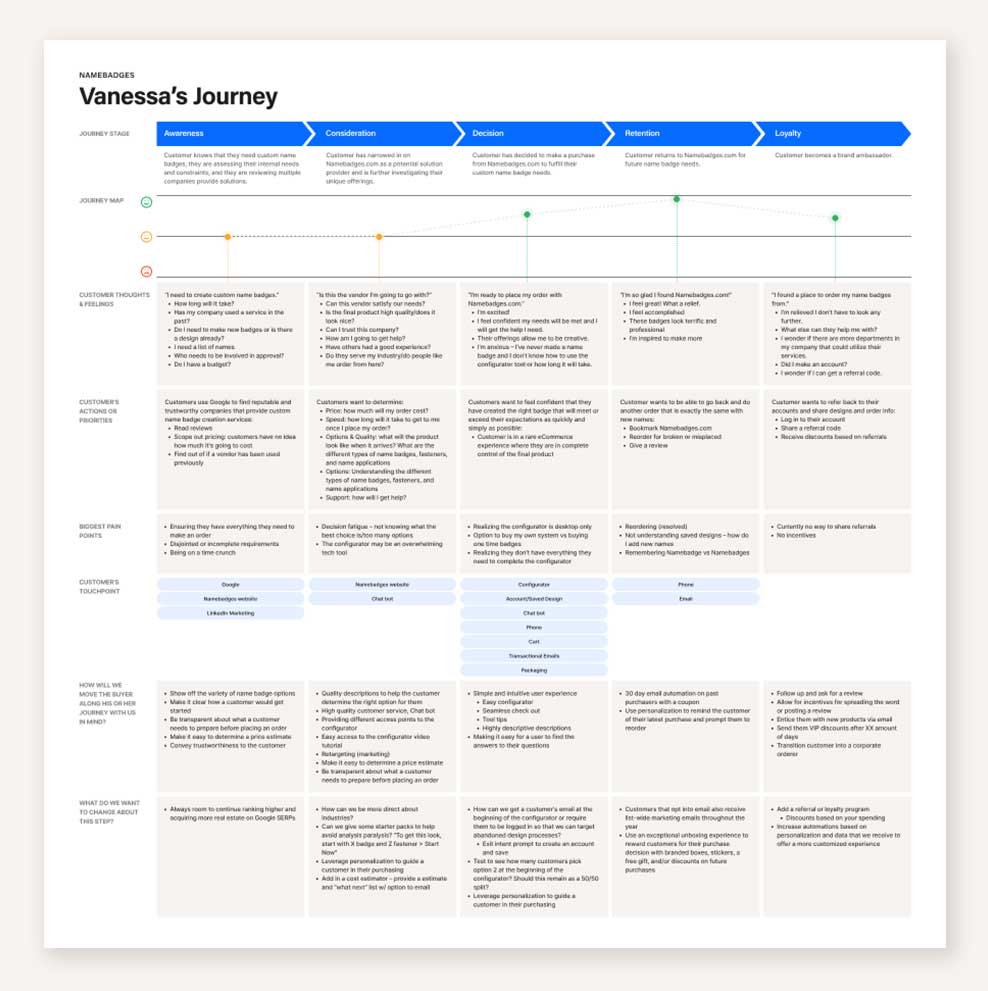As 2023 winds down, the countdown to executing your 2024 marketing strategy speeds up.
We’ve looked at the foundational importance of customer personas in elevating your company’s CX. Now it’s time to put those to work with journey maps.
Journey maps serve a dual purpose:
- To clearly show what matters most to your customers
- To align internal stakeholders on marketing priorities
Want to maximize your investment? They work best when looking beyond purchase to long-term loyalty. Gartner’s late-2021 survey of 362 global CX practitioners backs this up: “CX programs that exceed management expectations are 2.3 times more likely to have their CX efforts in marketing not primarily focused on the path to purchase but on the journey after acquisition.”
However, only 34% of respondents said they had “three or more years of experience developing end-to-end journey maps, and 83% report[ed] that their organization struggles to use customer journey maps to identify and prioritize CX efforts.”
Journey maps are critical for growing profit through customer loyalty — which only happens if they’re comprehensive, improved over time and actionable.
Start (but don’t stop) here
First things first, do you have a journey map for each of your customer segments?
If you’ve put in the time and covered the full end-to-end customer journeys, you have your single-source-of-truth for the coming year to inform tactical execution.
If not, make sure you have internal resources available before considering external tools to develop your own.
There’s no shortage of templates or guidance available. Some are better than others. We consider these to be solid starting points for your journey map development:
- We’ve shared this HubSpot piece internally more than a few times. Our strategists agree with the author’s assertion that it’s a useful resource for “How to Create Really Good Ones.”
- The Qualtrics “Customer Journey Mapping 101” article shows how and why an accurate journey map helps improve your business outcomes through better CX.
- Our in-house UX designers love collaborating with developers and clients in Figma, which has made free customer journey map templates available for the online whiteboard.
- The CX Lead offers several journey map examples for inspiration, including Simple, Visually Stunning and Super Detailed, among others.
- User Interviews breaks down what you must have and what’s simply nice to have in your journey map before digging into the pros, cons and pricing for 32 different tools and platforms.
Before you go all-in on anything, though, beware that software tools might not address your most critical challenges. Today’s AI can analyze vast amounts of data quickly to find trends and patterns — but keep in mind, it still has trouble grasping context for deep customer insights along with problematic inherent biases.
Journey mapping in design thinking
Useful journey maps are visualizations that tie data to action. Lightburn teams design ours to bridge the gap between the conceptual and practical. We have our eyes on execution so clients can add touchpoints, remove barriers and move toward increased sales.
Some strategists stop short of that goal. As Gartner’s Augie Ray notes, journey maps that focus only on the purchase funnel and not the end-to-end customer journey aren’t enough. “[Those] may assist with efforts to build awareness, inbound traffic and acquisition, but they cannot uncover the opportunities that influence customer satisfaction, loyalty and long-term advocacy.”
We agree — our process for strategists and the UX team takes a long-term view for customer retention for journey mapping in design thinking.
- Objectively define current user needs and behaviors
- Identify pain points and areas for improvement
- Develop more efficient processes
- Define benchmarks using sales and operational data
Journey mapping in action
The Cawley Company
Lightburn has worked closely with Cawley teams on continual improvements and digital marketing strategies since our original design and development project to launch their namebadges.com ecommerce site.
“The foundation of our ongoing work is strong customer personas and end-to-end journey maps,” said Lightburn’s Director of Production, Stacy Hannemann. “We revisit those together on a regular basis to inform strategy.”
Three years into the lifespan of the ecommerce store, journey maps helped identify the behaviors of repeat customers and where CX improvements could be made for a more seamless reorder process. To increase customer satisfaction and loyalty — and drive YOY revenue growth.


Journey mapping in action
Douglas Dynamics
Douglas Dynamics developed their customer persona and journey map in-house. We worked with stakeholders to revisit these foundational documents to inform 2024 digital projects and priorities.
“That journey map included an eight-year product lifecycle from the awareness stage through recommendation,” said Clay Patterson, our Director of Digital Marketing. “It helped define and design their budget plan based on need, impact and opportunity cost within digital marketing initiatives.”
As you level up your organization’s digital maturity, consider these lessons others have learned:
- Go fast but get what you need. You don’t have to get bogged down in a two-year investment to create a comprehensive, valuable journey map.
- Make it scalable and actionable. Your business is growing, and the marketing landscape has more tools available for personalization and automation for smooth execution.
- Be objective. An internal stakeholder might overvalue their team’s place in the journey — whoever owns the project should reside outside of marketing.
Questions about how journey mapping can help your team with acquisition, conversion rate optimization and re-engagement? Ask us anything.
